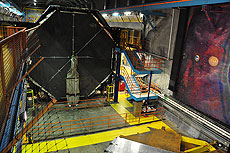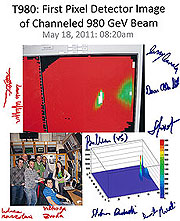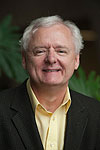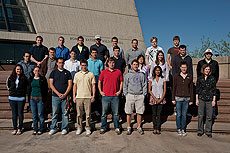|
Have a safe day!
Wednesday, May 25
2 p.m.
LHC Physics Center Topic of the Week Seminar - Sunrise, WH11NE
Speaker: Stephen Mrenna, Fermilab
Title: SUSY on the Back of an Envelope – Part 2
3:30 p.m.
DIRECTOR'S COFFEE BREAK - 2nd Flr X-Over
THERE WILL BE NO FERMILAB COLLOQUIUM THIS WEEK
Thursday, May 26
2:30 p.m.
Theoretical Physics Seminar - Curia II
Speaker: Kathryn Zurek, University of Michigan
Title: A Theory for Maximal Flavor Violation
3:30 p.m.
DIRECTOR'S COFFEE BREAK - 2nd Flr X-Over
THERE WILL BE NO ACCELERATOR PHYSICS AND TECHNOLOGY
SEMINAR TODAY
Click here for NALCAL,
a weekly calendar with links to additional information.
Upcoming conferences
|
|
Wednesday, May 25
- Breakfast: English muffin sandwich
- * Chicken noodle soup
- Steak sandwich
- Maple dijon salmon
- Mongolian beef
- California club
- Assorted sliced pizza
- Chicken pesto pasta
*Heart healthy choice
Wilson Hall Cafe Menu
|
|
Wednesday, May 25
Lunch
- Chopped shrimp Waldorf salad
- Strawberry cheesecake
Friday, May 27
Closed
Chez Leon Menu
Call x3524 to make your reservation.
|
|
Soudan laboratory is clean, safe and back in business
 |
| The cleanup of the MINOS cavern and the rest of the Soudan Underground Laboratory is complete. |
Two months after a fire broke out in the access shaft of the Soudan mine, the Soudan Underground Laboratory is again open for operation. Safety officers inspected the mine and laboratory last week and issued a permit for normal occupancy. The officers identified a short list of additional repairs, which will be carried out in the upcoming months. Work also continues on the Soudan mine shaft.
“The cleanup of the laboratory is complete, and the MINOS far detector is ready to take beam data with full magnetic field,” said Fermilab physicist Rob Plunkett, co-spokesperson for the MINOS neutrino experiment. “The small number of components we had to replace was consistent with a normal power outage."
The 5,000-ton MINOS far detector is located a half mile underground in the Soudan laboratory. In March, fire-fighting foam covered parts of the detector and the lowest part of the magnet coil was partially immersed in water. Laboratory staff gently heated the coil over the past two weeks to dry it out.
The CDMS experiment, located in a cavern adjacent to the MINOS detector, experienced no damage to its equipment except to a backup generator. Its cryogenic system recovered unscathed from the power outage triggered by the fire. CDMS scientists have removed the new particle detectors they were testing before the fire, and they will begin operation of an expanded experiment with more dark-matter detectors in September.
University of Minnesota building code inspectors and ES&H personnel from the university and Fermilab inspected the laboratory last Wednesday. The University of Minnesota manages the Soudan Underground Laboratory.
— Kurt Riesselmann |
Pixel detector to assist beam collimation experiments
 |
| Members of the crystal collimation study, a joint program of Fermilab's Accelerator Division, the Accelerator Physics Center, and the LARP program, celebrated their success with the pixel detector at the Tevatron in the Main Control Room on Wednesday, May 18 (lower left). The intensity profile in 2D (top image) and 3D (lower right) acquired by the pixel detector shows that halo particles were channeled away from the main beam with a bent crystal. |
For the first time, on Wednesday, May 18, physicists operated a tiny detector in the Tevatron that will help develop a technology to improve the quality of collision data.
The pixel detector, a device similar to a cell phone camera chip, could help improve beam collimation technology— technology that can remove unwanted particles from around the periphery, or halo, of the beam before they wreak havoc on equipment and data.
The achievement comes after several hurdles in the past year.
The detector was initially built by engineers in Fermilab’s Particle Physics Division for the CMS Forward Pixel Detector. In 2010, an engineering team from the Electronic System Engineering Department of the Computing Division took on the task of providing a readout system and software suite specifically for this experiment to allow operation inside the Tevatron vacuum and close to the beam.
Now, a team of physicists from the T-980 crystal collimator project is using the detector to perform beam collimation experiments.
Difficulties with installing the pixel detector in the beam arose when moisture trapped in the electronics prevented vacuum from being achieved in the beamline, said Gerry Annala from Fermilab’s Accelerator Division.
Once conditions were optimized to remove the water, the collaboration successfully installed the detector. They are now investigating the ability of devices made of bent crystals to remove halo particles and produce a tight, narrow beam suitable for clean particle collision experiments.
Read more
— Christine Herman |
Correction: Email links
In yesterday's Users' Meeting article, the email addresses for William Wester and Todd Adams were incorrect. The correct email addresses are wester@fnal.gov and tadams@hep.fsu.edu. The links have been corrected; we apologize for any inconvenience.
|
Ars photo tour: the Tevatron particle accelerator at Fermilab
From ars technica, May 20, 2011
Last week, I flew out a day ahead of our staff meeting in Chicago. Instead of enjoying the Windy City, however, I headed west, deep into Chicago's western suburbs. About an hour outside the city, past a few strip malls, a small sign indicated the next right turn would take me from an unremarkable suburban area into the place where the last particle of physics' Standard Model had finally been spotted: Fermilab.
Fermilab is the host of the Tevatron, which, until the LHC opened for business, was the biggest particle accelerator around, circling through nearly four miles of midwestern prairie. During its run, the Tevatron finally spotted the elusive top quark, and the huge volume of data it has generated over the years has recently provided hints that there may be new forces and particles. Nevertheless, its days are winding down as attention has shifted to the LHC. It will shut down for good in September.
Read more
|
|
Challenging magnets
Mike Lamm, head of the Magnet Systems Department and Mu2e Level 2 Manager for Solenoids, wrote this week’s column.
 |
Mike Lamm
|
For the past 18 months, the Technical Division magnet program has been working on the development of several complex magnets for Mu2e (pronounced mew-2-e), one of the flagship experiments of Fermilab’s Intensity Frontier program. A few weeks ago, we achieved an important milestone when our detailed, conceptual design for the Mu2e magnets passed a three-day Director’s Technical Design Review of the entire project.
The Mu2e experiment will provide a strong test for beyond the Standard Model theories. Mu2e will look for the predicted but not-yet-observed direct conversion of a muon into an electron, a process known as charged lepton flavor violation. We know that all quarks can change flavor, such as a charm quark turning into an up quark, and we have recently learned that leptons without charge can change flavor too, such as a muon neutrino transforming into an electron neutrino. Hence we suspect that charged leptons such as muons might be able to likewise change flavor by directly converting into an electron. If they do, it will be a very rare process, and its discovery will require a special beamline and particle detector.
The Mu2e experiment will smash an intense beam of protons from Fermilab’s Booster accelerator into a gold target to produce lots of low-energy muons. A magnet known as the production solenoid will slow and collect these particles (see graphic). A transport solenoid will guide the muons through the S-shaped chicane that weeds out unwanted particles. Then the muons will be captured in an aluminum target. If and when a muon converts to an electron within the target, an electron detector within a detector solenoid will identify the emerging electron.
The production solenoid and detector solenoid resemble the superconducting solenoid magnets currently used in Tevatron and LHC experiments, but with additional requirements. The production solenoid must achieve 5 Tesla, or 100,000 times the earth’s magnetic field--the highest central magnetic field of any solenoid in particle physics. Its coils will experience 170 tons of force during operation, or the weight of four fully loaded 18-wheeler trucks. The detector solenoid will be comparable in diameter to the massive ATLAS central solenoid at the LHC, but will be longer, with a total length of more than 11 meters. It will store about the same amount of energy as the ATLAS solenoid, but will feature a more uniform magnetic field.
The transport solenoid will be like nothing else ever built. Because of its complex S-shape its superconducting coils will experience strong forces and torques that will pull in opposite directions when the adjacent coils are forced to power down during an operational hiccup known as a quench. This made its design very challenging.
With the detailed, conceptual design of the Mu2e magnets approved and almost complete, we are moving one step closer to building this experiment, and one step closer to a better understanding of our universe.
|
New employees - May 16
 |
| First row, from left - Whitney Treadman, Paige Rogers, Richard Garcia, Michael Alber, Mike Irvin, Phil Albrecht, Novarah Kazmi, Lisa Reger, Jackie Zolna; Second row - Alex Garabedian, Joshua Heidorn, Alex Fishbeck, Adrian Mendez, Matt Kullen, Shirley Xiao, Liana Nicklaus, Matt Olderr, Andrew Rachmiller; Third row - David Maurin, Sean Smith, Jason Koll, Chad Becker, Marty Malecki, G. Addison Merchut, Greg DeFillippo, Ryan Washburn. |
|
ES&H weekly report, May 24
This week's safety report, compiled by the Fermilab ES&H section, includes no recordable incidents and two incidents that required first-aid treatment: An employee suffered low back and side back pain after moving his things from one office to another, and an employee suffered a small cut on his right forearm, possibly from the handle on a cabinet.
Find the full report here. |
|